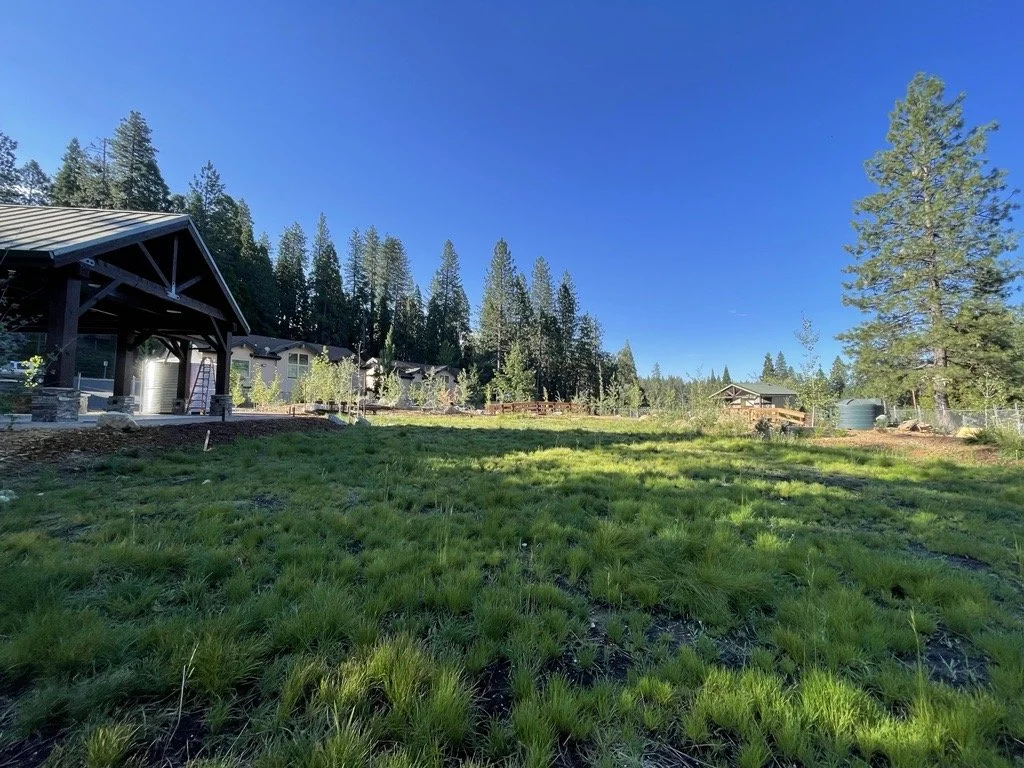Twain Harte Meadows Water Resilience Toolkit
Water connects us at home, at this park, and throughout California.
By using less water through plant choices, harvesting rainwater, reusing greywater, and slowing, sinking, and 'planting the rain', we clean water before it joins in Twain Harte's waterways, securing water supply, enhancing habitat, recreation and growing shade for generations to come.
DIY Toolkits | Contact THCSD| Map of Park | Discovery Labs | Story of Park (Before and After)
Learn more about what YOU can do at home.
Download the free Design Guides below.
Multiple Benefits of Nature-Based Solutions
-
Rainwater harvesting and stormwater best management practices reduce the volume of runoff entering creeks and rivers. Stormwater BMPs and Climate Appropriate Plantings clean and cool water. All of these impacts are building blocks for healthy waterways and improve both wildlife habitat and drinking water quality.
-
Rain tanks serve as both a primary or secondary source of potable water. Rainwater tanks are safe and reliable sources of water through drought and disaster. Tools that recharge groundwater like greywater reuse, stormwater gardens and Climate Appropriate Plantings ensure robust groundwater supplies that can help through severe drought. Fire BMPs enhance soil health and protect water quality.
-
When we slow water in stormwater gardens and through rainwater harvesting, it has a chance to sink into the ground and recharge groundwater supplies rather than rushing down storm drains and rivers to the ocean.
-
Healthy soils and irrigated vegetation help mitigate wildfire risk by creating a buffer between wildlands and urban infrastructure.
-
Stormwater BMPs, rainwater harvesting, and greywater reuse systems support trees and plants that provide shade and counteract the urban heat island effect. Regenerative Stormwater Conveyance approaches, Climate Appropriate Plantings and Low Impact Design tools help capture and slow stormwater, mitigating flood. Fire BMPs protect communities and landscapes from wildfire.
-
Healthy landscapes contribute to overall air quality improvements and water quality improvements, which benefit public health. Green spaces provide recreational areas for families and children, benefitting both physical and mental health.
-
Greywater reuse is a strategy used to irrigate fruit and nut trees and food-producing shrubs like blackberries, contributing to food security and localizing food supplies. Rainwater harvesting can support irrigation of all food crops, adding diversity to local food production.
-
Rainwater harvesting, mulch, carbon farming and greywater reuse are treatments that build soil by adding humidity, carbon, and nutrients. Healthy soils contribute to healthier plants and landscapes, and can help prevent or slow wildfire. Healthier soils are more absorbant and can hold more moisture which helps reduce runoff as well. Erosion reduction prevents extreme flooding.
-
Stormwater gardens, greywater and rainwater irrigated trees, shrubs and climate appropriate plantings provide significant patches of habitat for birds, insects and other wildlife .These same tools recharge groundwater, which increases stream flows, supporting robust habitat for aquatic species, fish, birds and others.
-
Mulching, efficient irrigation and soil amendments put nutrients back into the soil, enhancing soil health and reducing erosion.
Park History:
In 2016 the Cowell Trust of Juliette & Robert Cowell donated this land to the Twain Harte Community Services District to create a natural park area that would bring families & friends together to relax, play, & enjoy the beauty of the Twain Harte community. Over the following three years, local residents gathered to dream, collaborate & design the recreational features you see in the Twain Harte Meadows Park today. Our desire is that this park strengthens community & families for generations to come.
Twain Harte Community Stormwater Enhancement Project
A Journey through the Wonders of the Watershed:
Twain Harte Meadows Park showcases 11 educational discovery labs for visitors. Each discovery lab mimics various natural elements found in a greater watershed, becoming a microcosm of the Tuolumne River Watershed. Join Drip the Drop on this adventure to learn more about the importance of water systems and how they affect the natural world around us!
View the Stormwater Discovery Labs
Click on each image below to view full screen.














































